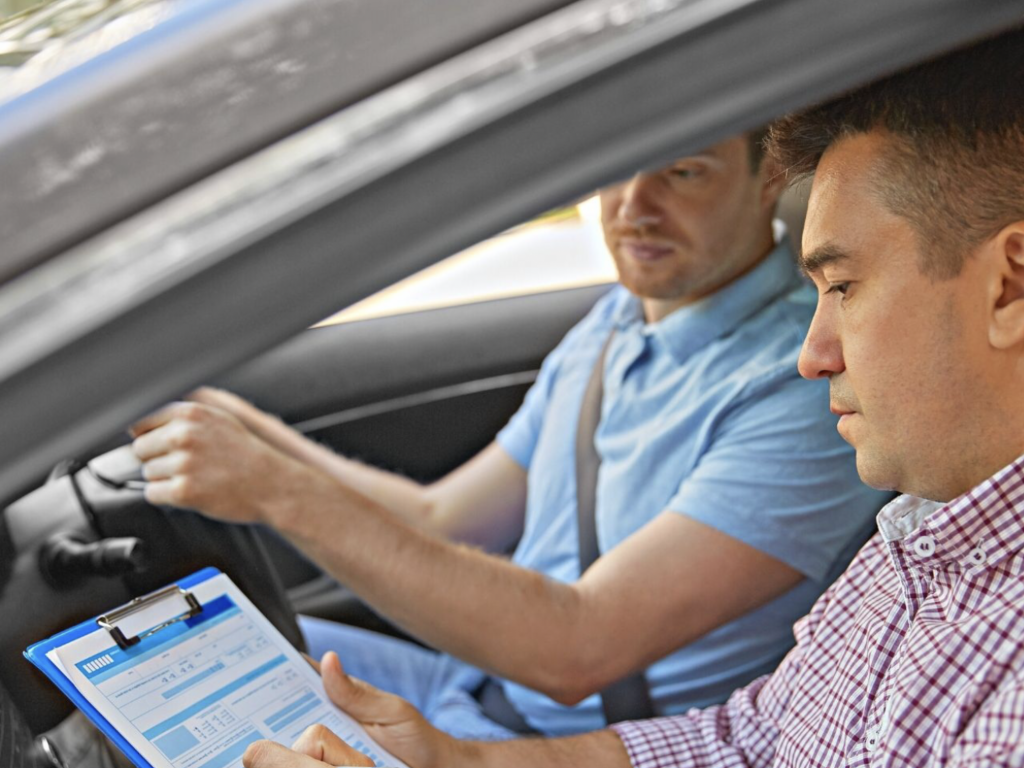The thought of starting a career as a driving instructor can be an exciting yet daunting proposition. Not only do you have the responsibility of ensuring that only safe and sensible drivers pass their tests, but also, with so many technical terms, abbreviations and highway code to remember, it can be hard to keep up.
But don’t worry, we’re here to help.
In this post, we will outline the process through our step-by-step guide to how to become a driving instructor.
If you want to embark on a career in this field, we’ll cover everything you need to know about becoming an ADI (approved driving instructor).
Why become a driving instructor?
Before we outline the process involved in becoming a driving instructor, it is probably worth touching upon the benefits and potential challenges of becoming one.
As a driving instructor in the UK, you will be able to enjoy working flexible hours, which you can schedule around your personal commitments and responsibilities. You should also have a skill that leads to long term job security because people will always want and need to take driving lessons, even during periods of economic uncertainty.
Depending on whether you work for a company or yourself, you can also be your own boss and, therefore, retain control over where you work, who you teach and how you teach. Moreover, it can be an incredibly rewarding job to help people achieve proficiency in this important life skill through the tips and knowledge you give them.
However, it is worth noting that, at times, being a driving instructor can be very stressful and demands a lot of patience, especially with people who are in the early stages of their learning experience.
Additionally, you may spend a lot of time on your own, as you won’t have many or any work colleagues and your car is likely to require regular maintenance due to it experiencing plenty of wear and tear.
Who can become a driving instructor?
To become a driving instructor, the DVSA has certain legal requirements that you’ll have to meet.
For a start, you must be at least 21 years old. You also must have a held a clean and valid UK driving licence within the category you want to teach i.e. car, lorry or motorcycle.
Additionally, you should have no more than five points on your licence and have not been banned from working with people under the age of 18 or ever been convicted of a sexual, violent, drug-related or financial crime.
You will also need to verify your eligibility status with the DVSA (Driving and Vehicle Standards Agency) – or, if you live in Northern Ireland, the DVA (Driver & Vehicle Agency).
Moreover, you must also undergo a DBS (Disclosure and Barring Service) check prior to sending off your application – even if you have had one before.
What skills and personal traits do you need?
To become a driving instructor there are certain skills and personal traits you should possess. You will, of course, need to be professional at all times. But also, you should enjoy working with people of different ages and backgrounds.
Additionally, you should have good interpersonal skills, a sound character, be tactful and patient and able to relay precise and clear instructions to your students.
It also helps if you have good eyesight (you need to be able to read a licence plate from 27.5 metres away with or without your driving glasses), and to be able to react confidently, correctly and quickly in a wide range of traffic scenarios.
How to become a driving instructor
To become a driving instructor, you will need to take an approved ADI test, a list of which you will find on the Gov.UK website.
This test takes three forms – theory, practical and instruction.
Part 1 – theory test
The theory test for driving instructors is quite similar to the one you take when learning to drive. However, the questions are more challenging compared to the standard theory test.
The test consists of two parts: multiple-choice questions and a hazard perception test.
In the multiple-choice section, you will face 100 questions, and to pass, you must score at least 85%. This section will cover topics such as road procedure, traffic signs and signals, driving law, and teaching techniques.
The hazard perception part of the test includes 14 questions, and to pass it, you must score at least 57 points. This section will evaluate your driving awareness and reaction time by displaying a series of video clips that contain at least one hazard. Your task will be to spot the risks and respond accordingly.
If you fail your theory test, don’t worry. You can retake it as many times as you want until you pass. Once you pass, you can book the second part of the test.
Part 2 – practical driving test
For this section of the test, you will need to demonstrate your ability as a driver. This involves being assessed on the following skills:
- awareness of other road users and pedestrians
- understanding of road procedures and lane discipline
- judgement of potential hazards and speed
- dealing with challenging road scenarios
In addition, you will be tested on your ability to demonstrate a good level of control and skill when handling the vehicle, as you will need to relay this to your student. Subsequently, during your test, you’ll be requested to perform some of the following manoeuvres including:
- reverse parking
- parallel parking
- stopping on the right-hand side of the road, reversing for two full car lengths before rejoining traffic
- driving into a bay before reversing out of it
- pulling up adjacent to a car before reversing into a space at the rear of the car (you must stop near the curb at least within two lengths of the car)
In order to pass this aspect of the test, you will need to achieve no major faults and fewer than five minors.
Part 3 – Instruction ability test
In the final section of the test, your teaching ability will be assessed. This will involve teaching a real student via a lesson that you have planned, during which time an examiner critiques your teaching skills.
Overall, you get tested on aspects like your teaching strategies, risk management and lesson planning. To pass it, you must score a minimum of 31 out of 51 otherwise, you will fail.
How long does the process take?
The process of becoming a fully qualified driving instructor can take anywhere between six and twelve months – depending on how much time you can devote to it.
That said, you may experience delays due to factors such as the availability of exams or DBS checks. However long it takes, you should always prepare thoroughly for each stage.
What does it cost to become a driving instructor?
When taking your test to become a driving instructor, you will incur various costs for the tests and official certifications. At the time of writing, the cost for the tests is:
– £81 for part 1
– £111 for part 2
– £111 for part 3
Additionally, you will also need a trainee driving instructor license in order to complete parts two and three of the exams. Currently, this license costs £140.
Once you have passed the tests, you need to pay £300 to get the official accreditation for being an approved driving instructor. It is worth noting that you will need to renew this certificate every four years, which will cost £300 every time you do so.
Other costs to consider are the price of a car with dual controls (the extra set of pedals that reside in the passenger seat section for the instructor).
You can either purchase dual controls and have them fitted to your personal car or buy a car that already has the pedals installed. For the convenience, many instructors prefer the latter option.
How much do driving instructors get paid?
The amount a driving instructor can earn will depend on several factors.
Typically, driving instructors charge by the hour, so of course, the number of hours they work is a significant contributory factor to determining their earning potential.
According to the National Careers Service, most driving instructors work between 30 to 40 hours every week. For an experienced instructor, this can translate to an average salary of around £32,500 per year.
What to do once you have passed your test
Once you have passed your test to become a driving instructor, you will need to decide if you want to work for a driving school or be self-employed.
Becoming self-employed often seems like a daunting step, but it can open up a lot of exciting opportunities.
If you do want to set up your own business, you will need to register as self-employed and pay tax through a process of self-assessment every year by 31st January.
How do you grow your business?
If you decide to become a self-employed driving instructor, you will need to quickly build up a customer base.
There are several ways you can do that, including traditional marketing strategies such as signage on your car, advertisements in newspapers and direct mail.
You also might want to set up your own website and should consider registering your details to become a trusted driving instructor with EZLicence UK.
Develop lesson plans
As a qualified driving instructor, you will need to plan lessons for your students. There are several things you will need to take into consideration when doing this, including the following factors:
First of all, you will need to find an appropriate driving route for the learner. You will also need to make sure it is appropriate for the learner’s experience level,
During the lesson, you should be able to recognise in which areas students need to brush up on their skills and techniques. Additionally, you will need to adapt your approach to what the learner specifically wants to focus on.
Logistically, you also need to make sure you give yourself plenty of time to get from one lesson to another.
How much is driving instructor insurance?
One of the most important things you will have to do as a driving instructor is to manage the risk of teaching learner drivers. For this reason, you will need good insurance.
Typically, driving instructor experience includes public liability insurance in the case of someone being injured or if property is damaged as a direct result of your business. You will also need employer’s liability insurance if you intend to hire staff.
It might also be worth adding excess to your insurance cover for your own peace of mind, should you ever need to make a claim.
 Automotive Blog Automotive Blog brings you the latest news, car reviews and information on the automotive industry.
Automotive Blog Automotive Blog brings you the latest news, car reviews and information on the automotive industry.




